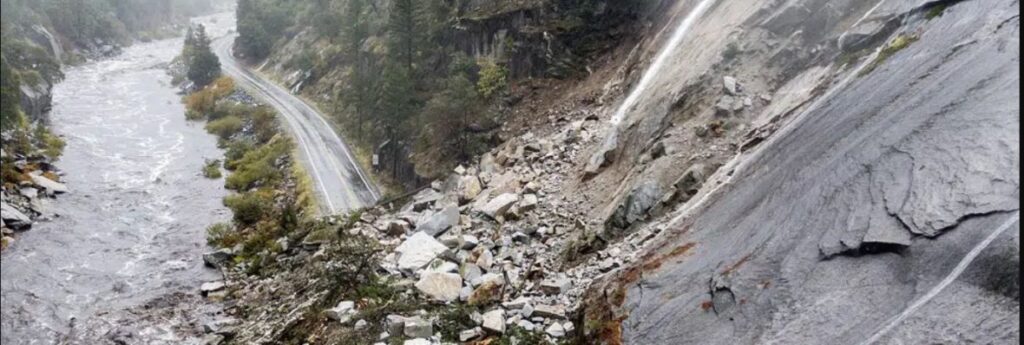California’s weather was calmer, and skies cleared yesterday after the state’s ninth atmospheric river in a three-week series of major winter storms churned through the state on Monday, leaving mountain driving dangerous and the flooding risk high near swollen rivers even as the sun came out in some areas. And mud. Lots of mud.
At the same time, a backcountry avalanche warning was issued for the central Sierra, including the greater Tahoe area.
“If you must travel, be prepared for dangerous travel conditions, significant travel delays and road closures,” the weather service office in Sacramento warned – not least from the prospect of devasting and dangerous landslides, which have killed 20 people since December.
Mudslide risks remain a risk, say forecasters, because the state is so saturated. So far the debris has mostly blocked roads and highways and has not harmed communities as in 2018 when mudslide roared through Montecito, killing 23 people and wiping out 130 homes.
But more rain is in the forecast, increasing the threat.
Experts say California has learned important lessons from the Montecito tragedy and has more tools to pinpoint the hot spots and more basins and nets are in place to capture the falling debris before it hits homes. But the recent storms are putting those efforts to the test as climate change produces more severe weather.
Why is California prone to mudslides?
California has relatively young mountains from a geology standpoint, meaning much of its steep terrain is still in motion and covered in loose rocks and soil that can be sloughed off easily, especially when the ground is wet, according to geologists.
Almost all of the state has received rainfall totals of 400% to 600% above average since Christmas, with some areas receiving as much as 750 mm of precipitation, causing massive flooding.
Since New Year’s Eve, the California Department of Conservation’s landslide mapping team has documented more than 300 landslides.
The state’s prolonged drought has made matters worse.
Dan Shugar, an associate professor of geoscience at the University of Calgary, said drought can have a counterintuitive effect when combined with the incredible rainfall California has seen in recent days.
“You’d think if the ground is dry it should be able to absorb a lot of water, but when ground becomes too dry, the permeability of the ground actually decreases,” he said. As water runs off the hardened soil, moving downward and picking up energy, it can begin carrying soil and debris away, he said.
Added to that, wildfires have left some hillsides with little to no vegetation to hold the soil in place.
What are the most vulnerable areas?
The most vulnerable areas are hillsides that have burned in the past two to three years with communities below them, said Jeremy Lancaster, who leads the California Department of Conservation’s geological and landslide mapping team.
That includes areas that recently burned in Napa, Mariposa, and Monterey counties, he said.
In 2018, the deadly mudslides in Montecito occurred about a month after one of the largest fires in California’s history tore through the same area, charring 280,000 acres.
Montecito is sandwiched between the Santa Ynez mountains and the Pacific coast. On the fifth anniversary of that tragedy, the entire community was ordered to evacuate on Jan. 9 as rains pummelled the area and debris blocked roads.
Lancaster warned that the threat of landslides will linger long after the rains have subsided as the water seeps 15 to 30 m. into the soil, dislodging things.
“They can occur weeks later, if not months,” he said.
What can be done to protect communities?
Lancaster said California has dramatically increased its efforts to identify hotspots since the Montecito mudslides. His department continually updates its map so local communities are aware and can make decisions, including whether to evacuate an entire community.
The state is also working on a system to better pinpoint how much rain might trigger a landslide.
Marten Geertsema, who studies natural hazards and terrain analysis at the University of Northern British Columbia, said agencies use a variety of tools to gauge the likelihood of landslides in a given area, including terrain maps and lidar – pulsed light from lasers to penetrate foliage to see the ground. Then they can watch for early warnings, such as changes over time in photos taken from the air, or from satellites, or in data from GPS monitoring stations, tilt meters and or other on-site instrumentation.
What is the most effective defense?
One of the best ways to manage landslides is with debris basins – pits carved out of the landscape to catch material flowing downhill.
But basins, which can require a lot of land, can also disrupt the natural ecosystem and lead to beaches needing to be replenished by collecting sediment that flows out of the canyons, according to experts.
And they are costly, said Douglas Jerolmack, a professor of environmental science and mechanical engineering at the University of Pennsylvania. And if old debris isn’t removed, they can be overwhelmed by new landslides or mudslides.
Some might also not be big enough to deal with future slides worsened by climate change, Jerolmack said.
And nothing is cheap. Santa Barbara County’s spent US$20 million on a new basin after 2018.
With the recent storms, more than half of California’s 58 counties have been declared disaster areas and repairing the damage may cost more than $1 billion.
Meanwhile, forecasters were keeping their eyes on a storm forming in the Pacific to see if it gains enough strength to become the state’s 10th atmospheric river of the season – as early as today.

